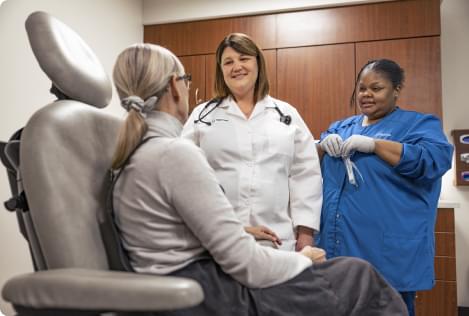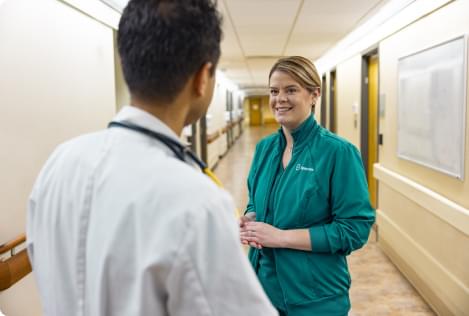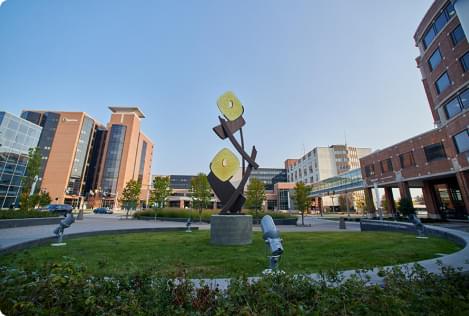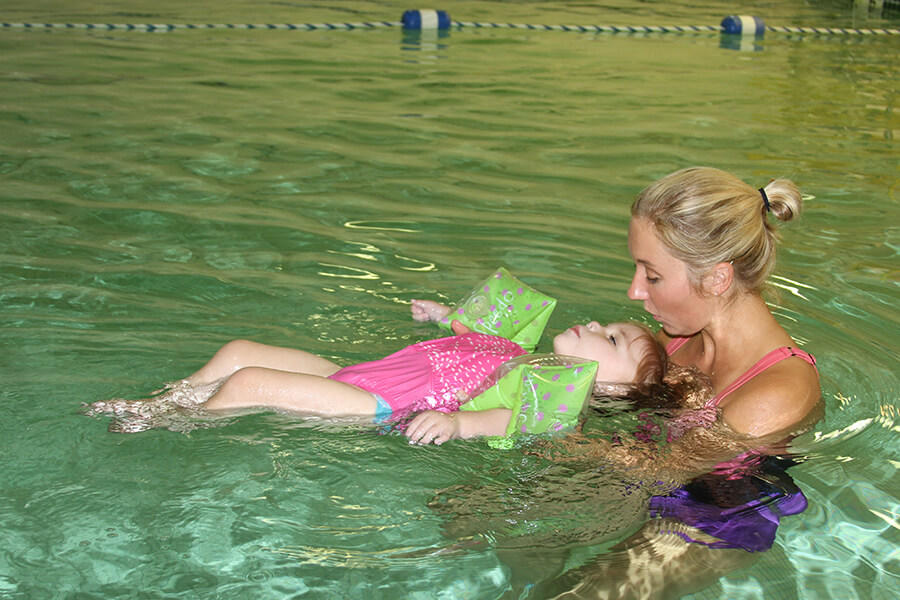The Pediatric Rehabilitation Therapists use a variety of therapies and treatments to meet you child where they currently are developmentally and assist your child in reaching their highest potential. Every child requires a different path to accomplish their goals and dreams. Following a comprehensive evaluation your child’s therapist will work with you to develop a treatment program that includes many different therapies and treatments that will assist you in accomplishing your goals. Whether your child needs help with speaking, assistance with learning to walk, strengthening after an injury or assistance with regulating their own body there is a treatment program that will benefit your child. This page will help you explore some of the treatment options that we offer, however because we are constantly learning and growing this is not an all-inclusive list of what UM Health-Sparrow has to offer you. Please contact us if you have any further questions.
Some of the therapies we offer include:
Aquatic Therapy
Therapeutic activity can be completed in a water medium as an alternative to therapy sessions in our gym or as an adjunct to therapy sessions in the gym. The hydrostatic pressure of the water provides proprioceptive input that your child with sensory needs may be seeking. The warmth of the pool allows for improved stretching with your child who has increased tone. The hydrostatic pressure and buoyancy of the pool will allow your child who is struggling with walking to walk independently with ease. Following a comprehensive evaluation, your child’s therapist may recommend that all or a portion of the therapy sessions be completed in UM Health-Sparrow’s full size pool. Your child’s therapist will work with you to design a specific set of exercises and activities to complete in the pool for your child’s benefit.
UM Health-Sparrow’s Rehabilitation Pool and room is maintained at a therapeutic temperature to assist with relaxation of muscles during stretching and exercise. During therapeutic activity in a water medium children show an improved ability to move around with the assistance of water.
Benefits:
- Self-regulation
- Improved range of motion secondary to relaxation of stiff joints and tight muscles
- Enhanced motor planning
- Improved active involvement and exploration of movement
- Improved alignment of joints and muscles
- Improved strengthening in all muscles secondary to the natural resistance of water
Augmentative and Alternative Communication
Children without functional verbal or sign language may be candidates for augmentative or alternative communication devices or techniques. Our team is able to evaluate your child and make recommendations as to the best device or technique to assist in communication. We also provide training to help the child and family learn to use a communication device most effectively.
Benefits:
- On-site Speech Pathologists that evaluate a child's needs for alternative or augmentative communication
- Family training in using a communication device
- Collaboration with Occupational Therapists on staff to evaluate a child's needs and train the family in using the device
- Collaborative relationships with device manufacturers to assist in choosing the most appropriate device
Bal-A-Vis-X (Balanced Auditory Vision Exercises)
A collection of 300 exercises that require a combination of rhythmic auditory, visual and motor responses. Patients either use racquet balls or sand-filled bags for the activities that range from simple to extremely complex depending on their personal needs. Bal-A-Vis-X activities can be completed by the Patient alone or with a therapist. Improvements in overall focus, visual attention, bilateral coordination, sensory regulation are seen in Patients who do Bal-A-Vis-X.
Cleft Palate Clinic
Our Speech Pathologists participate in the Mid-Michigan Craniofacial Anomalies Clinic, assessing the speech, language, and feeding needs of children with clefts of the lip and palate, as well as other craniofacial anomalies. Other professionals that provide care at this clinic include pediatricians, orthodontists, otolaryngologists, social workers, dietitians, and dentists. We make referrals and recommendations for additional services as appropriate.
Benefits:
- A multi-disciplinary team working with your child
- Speech Pathologists that address oral motor and feeding issues associated with cleft lip and palate, as well as other craniofacial anomalies
- Speech Pathologists that address the speech and language development of children with clefts and other craniofacial anomalies
- Referrals for additional speech, language or feeding therapy as appropriate
- Collaborative relationships with local schools and other facilities to help meet your child's needs
Cognitive Rehabilitation Therapy
Cognition includes memory, focus and concentration, mental planning and organization of information, and higher level thinking skills. These skills can be affected by a traumatic brain injury, surgery, stroke, or other illness. our therapists will work with your child to help them regain skills in these areas and to learn strategies to assist in their daily functioning at home, in school, and in the community.
Benefits:
- Improved focus and concentration
- Improved memory
- Improved ability to plan and organize
- Strategies to increase mental organization
Constraint Induced Movement Therapy (CIMT)
CIMT assists in improving the functioning of an affected limb by restraining the unaffected limb with a cast, splint or wrap. Your therapist will create a personalized plan for how often to wear, remove, or replace the restraint. Improvement is seen in the range of motion, strength and coordination of the affected extremity while completing everyday activities. Plans are designed to work into your child’s lifestyle and can be coordinated around school, sports and various activities. Your child will attend therapy sessions focused on constraint induced movement therapy goals.
Benefits:
- Increased range of motion in the affected limb
- Increased strength in the affected limb
- Increased fine motor coordination of the affeced hand
- Improved independence with activities of daily living
- Refined grasp and pinches in affected hand
Dysphagia (Swallowing) Therapy
Disorders of swallowing can interfere with a child's ability to eat an age-appropriate diet or to manage food and liquids appropriate for their age and developmental level. Swallowing therapy will address oral-motor delays, sensory aversions, and texture tolerance. Recommendations will be made to ensure your child can enjoy nutrition to their ability level while maintaining their health and safety. If recommended, our team can perform Videoflouroscopic swallow studies to evaluate your child's ability to chew and swallow safely.
Benefits:
- Increased ability to manage age-appropriate food and liquids
- Reduce reliance on supplemental feeding methods
Integrated Listening Systems
A multi-sensory program for improving brain function. Visual, auditory and vestibular systems are engaged to strengthen existing pathways in the brain while creating new connections as well. Children will listen to the bone-conducted, modulated music while completing a variety of activities that integrate the right and left sides of the body. A variety of programs can be tailored to your child to assist in improving sensory and motor coordination, Attention and Concentration or Reading and Comprehension. Following evaluation your child’s therapist will design a program that is individualized to meet your child’s needs
Integrated Listing systems combine’s three distinct components to achieve the outcome: Auditory component involves listening to treated music selections that are organized in a specific, sequenced design to help achieve the overall goals of improving brain function and skill acquisition. The movement component consists of a set of activities with equipment designed to provide multi-sensory input. The Language component is a unique program of receptive and expressive language activities that may be introduced following one of the auditory sessions, or be intertwined with a session.
Benefits:
- Concentration and focus
- Cognitive skills and memory
- Reading and writing
- Visual, auditory and motor integration
- Processing speed
- Mental and physical energy
- Self-confidence
- Social engagement
- Mood and emotional regulation
If you would like to explore more information regarding Integrated Listening Systems please visit their website at www.integratedlistening.com.
Scar Management
Scar tissue that forms following surgery or injury can limit your child’s range of motion and function as it heals around joints. In order to prevent the restriction in motion a therapist will massage and stretch the tissue with moisturizing lotions and silicone gels. Parents are educated on massage techniques and silicone gel use to assist in the ability to move and decrease the appearance of the scar.
Benefits:
- Reduces redness around the scar
- Reduces height of the scar
- Improves range of motion in the joint near the scar
- Improves appearance of the scar
Sensory Integration
Involves how people use and organize information provided by all the sensations within the body and from the external environment and underlies the development of learning, social skills, and motor actions. Lansing Pediatric Rehabilitation offers a wide range of treatments and therapies, with a personalized approach to help your child reach their goals.
The brain needs to be able to register sensory information and unconsciously filter relevant information. Sometimes one or more senses can over or under react to stimulation which causes a variety of problems. Difficulties with sensory processing can lead to problems with attention, social skills, coordination, and fine motor skills. Our specialized therapists are trained in a variety of programs including Wilbarger brushing program, Brain gym, How Does Your Engine Run and many more to assist your child in modulating sensory systems, improving self-regulation, enhancing motor planning ability, all while improving efficient organization of sensory information.
Benefits:
- Modulation of sensory systems
- Self-regulation
- Improve function in home and school
- Improve independence with ADLs
- Maximize functional ability to perform daily and recreational activities
- Enhance motor planning ability
- Active involvement and exploration of environment
- Efficient organization of sensory information
Serial Casting
Serial casting involves applying casts at routine intervals as range of motion improves, with the goal of restoring joint mobility. The cast is used to immobilize a joint that is lacking full range of motion. It holds the joint in place where the muscle has slight tension. Each cast gradually increases the range of motion in the affected joint. Serial casting can be used for a variety of conditions such as cerebral palsy, closed-head injury, muscular dystrophy, spina bifida, brachial plexus injury, and other neurological disorders.
Benefits:
- Non-painful/conservative method for improving range of motion
- Reduces muscle contracture
- Temporarily reduces spasticity
- Normalizes biomechanical joint alignment
- Improves overall postural alignment and improves gait pattern
Serial Splinting
Serial splinting involves applying splints at routine intervals as range of motion improves, with the goal of restoring joint mobility. The splint is used to immobilize a joint that is lacking full range of motion. It holds the joint in place where the muscle has slight tension. Each splint gradually increases the range of motion in the affected joint. Your therapist will guide you on completing range of motion on your child’s joint in conjunction with the serial splinting.
Benefits:
- Improves range of motion
- Reduces muscle contracture
- Temporarily reduces spasticity
- Normalizes biomechanical joint alignment
- Can be removed for bathing and grooming
Speech and Language Therapy
Disorders of speech and language can interfere with a child's ability to communicate with others and to participate socially in the community. Our team evaluates and treats disorders of speech intelligibility, fluency (stuttering), apraxia of speech, and receptive and expressive language development. These disorders can result from delayed development, autism, hearing loss, genetic syndromes, disease, or injury. Your therapist will work with you to develop a comprehensive plan to address the needs of your infant, child, or adolescent.
Benefits:
- Improved speech intelligibility
- Improved language comprehension
- Increased ability to express thoughts and ideas
- Increased speech fluency
- Reduced communication frustration
Upper Extremity Orthotics
Devices that are applied externally and to the upper extremities to restore or improve certain functional and structural characteristics of the musculoskeletal and nervous systems. Many of our hard upper extremity orthotics are designed by the occupational therapist to meet the individual needs of your child. Soft upper extremity orthotics or dynamic upper extremity orthotics are created in conjunction with a local orthotist. Your occupational therapist will work closely with the orthotist in the community to design an upper extremity orthotic to meet your child’s needs.
Benefits:
- Improve range of motion
- Improve joint stability for increased coordination
- Increase functional use of the affected extremity during play
- Increase independence in activities of daily living



